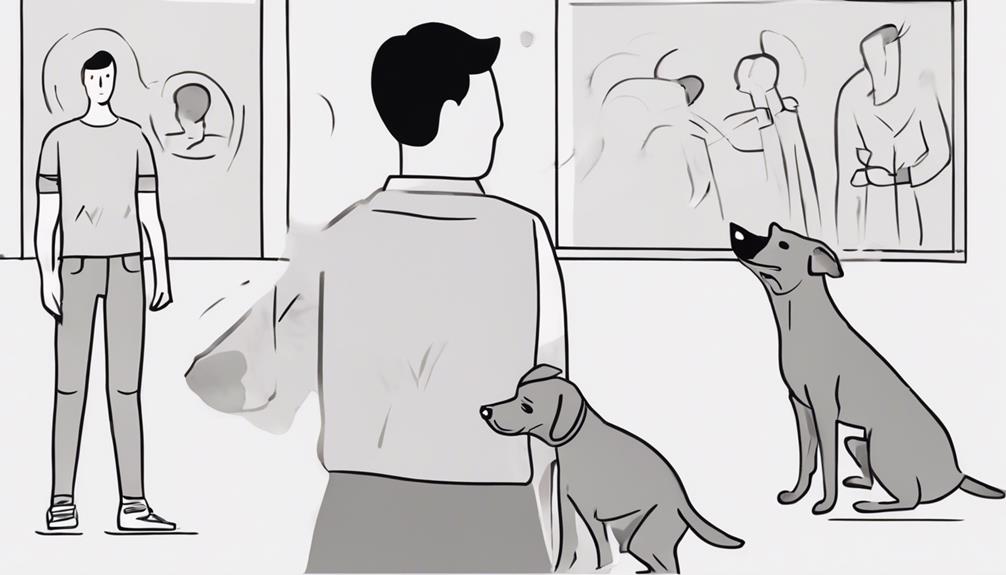Why Are Dog Communication Myths So Prevalent?
You might have noticed that there are some common misconceptions surrounding how dogs communicate with humans.
Have you ever wondered why dog communication myths seem to persist despite the availability of accurate information?
Let's explore the underlying factors contributing to the prevalence of these misunderstandings in our interactions with our canine companions.
Canine Body Language Misunderstandings
If you want to understand your dog better, don't fall for common misconceptions about their body language. Breed-specific communication and evolutionary influences play crucial roles in how dogs interact and express themselves.
One common misconception is that all dogs wag their tails when they're happy. While tail wagging can indicate happiness in many breeds, it can also signal anxiety, fear, or even aggression depending on the context and the individual dog. Understanding the subtle nuances of your dog's body language can help you decipher their true emotions accurately.
Evolutionary influences have shaped how dogs perceive and convey body language. Dogs have evolved alongside humans for thousands of years, leading to a deep bond and a shared communication system. However, misinterpreting a dog's body language can lead to misunderstandings and potential conflicts.
Human Projection Onto Dog Behavior
Beware of projecting human emotions onto your dog's behavior, as this can lead to misunderstandings and misinterpretations of their true intentions. Humans have strong projection tendencies, often attributing complex emotions to their furry companions. This can result in behavioral misconceptions, where actions are misread through a human lens rather than understood in the context of canine communication.
For instance, if your dog greets you with a wagging tail, it's easy to assume they're happy because humans associate this behavior with joy. However, in the canine world, a wagging tail can signal various emotions, including anxiety or tension. By assuming that your dog is always expressing emotions in a way familiar to humans, you might miss important cues about their actual state of mind.
To avoid falling into the trap of human projection onto dog behavior, strive to learn and understand canine communication on its terms. This can lead to a deeper bond with your dog based on mutual understanding rather than misconceptions driven by human interpretations.
Misinterpretation of Vocalizations
Avoid assuming that your dog's vocalizations always align with human emotions, as misinterpreting their sounds can lead to misunderstandings in communication.
When it comes to breed-specific vocalizations, each type of dog may have its unique way of expressing emotions through sounds. Misinterpretation of these breed-specific vocalizations can result in confusion between you and your furry friend.
Additionally, contextual cues play a crucial role in understanding your dog's vocalizations. The environment, body language, and situation your dog is in can greatly impact the meaning behind their sounds. Without considering these contextual cues, vocalizations may be easily misunderstood, leading to communication breakdowns.
To strengthen your bond with your canine companion and improve communication, it's essential to pay attention to both breed-specific vocalizations and the context in which these sounds are made. By doing so, you can better understand your dog's needs and emotions, fostering a deeper connection between the two of you.
Anthropomorphism Impact on Communication
To understand the impact of anthropomorphism on communication with your dog, it's crucial to recognize the differences between human and canine behavior. One common pitfall is emotional anthropomorphism, where you attribute human emotions and intentions to your dog. This can lead to misunderstandings because dogs don't think or react like humans.
For example, if your dog knocks over a trash can, it's not out of spite but likely driven by curiosity or the smell of food. Linguistic misinterpretations in communication can also occur when you assume your dog understands human language the way another person would. While dogs can learn to associate words with actions, they primarily rely on body language, tone, and context to interpret messages.
Therefore, relying solely on words without considering these other factors may lead to confusion. By being aware of these anthropomorphic tendencies, you can improve your communication with your furry friend and strengthen your bond.
Lack of Understanding Dog Social Hierarchy
Understanding dog social hierarchy is essential for effective communication with your canine companion, as it influences their behavior and interactions with you and other dogs. Misconceptions around dominance and pack structure can lead to misunderstandings in how we perceive our dogs' actions and needs. Here's why delving deeper into dog social hierarchy is crucial:
- Dominance myth: Believing that your dog is constantly trying to assert dominance over you can create unnecessary power struggles and may lead to behavior issues due to misinterpretation of their actions.
- Pack structure misconception: Thinking of your household as a pack with you as the alpha and your dog as a subordinate can create an unhealthy dynamic, affecting your relationship and causing stress for both you and your furry friend.
- Misreading social cues: Failing to understand your dog's social cues and signals based on their hierarchical behavior within their social groups can hinder effective communication and bonding between you and your pet.
Influence of Media Portrayals on Myths
Media portrayals play a significant role in perpetuating myths about dog communication, shaping public perceptions and influencing how individuals interact with their canine companions. Often, media stereotypes and misinformation create unrealistic expectations, leading to misunderstandings about what dogs are trying to communicate.
For instance, the idea that a wagging tail always means a dog is friendly is a common misconception perpetuated by media portrayals. Such influences can lead to misinterpretations of a dog's behavior and potentially dangerous situations.
These misconceptions can also stem from how dogs are portrayed in movies, TV shows, and advertisements. Dogs are often anthropomorphized, attributing human emotions and thoughts to them, which can lead to misunderstandings of their actual communication signals.
It's crucial to be aware of these influences and strive to educate oneself about accurate dog communication to foster a better relationship with your furry friend. By being mindful of the influence of media portrayals on myths about dog communication, you can better understand and respond to your canine companion's needs.
Failure to Recognize Stress Signals

Misinterpreting a dog's stress signals can lead to misunderstandings and potential conflicts in your interactions with them. It's crucial to pay attention to the stress indicators your furry friend may be displaying. Here's why recognizing these signals is vital:
- Miscommunication: Dogs communicate primarily through body language. Missing or misinterpreting their stress indicators, such as lip licking, yawning, or whale eye (when you see the whites of their eyes), can lead to confusion and escalate a situation unnecessarily.
- Behavioral cues: Your dog's behavior is a key indicator of their emotional state. Aggression, avoidance, or excessive panting could be signs of stress that are often misread as disobedience or moodiness.
- Misreading: When you misread your dog's stress signals, you risk pushing them past their comfort zone. This can result in a breakdown of trust between you and your pet, impacting your bond and overall relationship.
Cultural Differences in Dog Communication
To better comprehend your dog's behaviors and communication cues, it's essential to consider how cultural variations can influence their interactions and responses. Cultural perceptions play a significant role in how individuals interpret nonverbal cues from dogs. In some cultures, certain dog behaviors that are seen as acceptable or even positive may be viewed differently elsewhere. This can lead to misunderstandings and miscommunications between dogs and their owners.
Moreover, social cues also vary across different cultures, impacting how dogs interact with humans and other animals. Understanding these social cues can help prevent conflicts and strengthen the bond between you and your furry companion. Additionally, language barriers can pose challenges in interpreting a dog's communication signals. In multicultural environments, where commands or cues may be given in different languages, dogs might struggle to understand or respond appropriately.
Frequently Asked Questions
How Can Cultural Differences Impact the Way We Interpret Dog Communication?
Cultural differences can greatly impact how you interpret dog communication. Misinterpretations may arise due to language barriers or different societal norms regarding pet behavior.
For example, a gesture that's seen as friendly in one culture might be viewed as aggressive in another. Understanding these differences is crucial in ensuring effective communication with dogs and avoiding misunderstandings that can lead to conflicts or incorrect assumptions about a dog's intentions.
What Role Do Media Portrayals Play in Perpetuating Myths About Dog Communication?
Media influence greatly impacts how people perceive dog communication. Portrayals in movies, TV shows, and social media often misinterpret behavioral cues, leading to widespread myths.
These depictions can influence your understanding of dogs' signals and body language. Be cautious of media representations and consider consulting reliable sources to better comprehend your furry friend's communication.
Are There Any Specific Stress Signals That People Often Fail to Recognize in Dogs?
You mightn't always notice it, but dogs communicate stress through body language and anxiety signals. Often missed are subtle signs like lip licking, yawning, or avoiding eye contact. Vocalizations, like whining or growling, can also indicate fear responses.
Learning to recognize these cues can help you better understand your furry friend and improve your communication with them. So pay attention to these signals to strengthen your bond with your pup.
How Do Humans Project Their Own Emotions Onto Dog Behavior, Leading to Misunderstandings?
When you project your emotions onto dog behavior, you might mistakenly attribute human-like feelings to them. This can lead to misconceptions and emotional misinterpretations.
Dogs communicate differently than humans, so it's important to understand their unique signals and behaviors. By recognizing and respecting these differences, you can build a stronger bond with your furry friend and avoid misunderstandings.
Why Is It Important to Understand the Social Hierarchy Within a Pack of Dogs for Effective Communication?
Understanding hierarchy and pack dynamics is crucial for effective communication with dogs.
By recognizing the social structure within a pack, you can better interpret their behaviors and respond appropriately.
Dogs rely on hierarchy to establish order and maintain balance in their interactions.
Being aware of this allows you to communicate more clearly with your furry companions, strengthening your bond and fostering a harmonious relationship based on mutual understanding.
Conclusion
So next time you interact with a dog, remember to pay attention to their body language, vocalizations, and social cues. Avoid projecting human emotions onto them and be mindful of their stress signals.
By understanding and respecting their communication, you can build a stronger bond with your furry friend and ensure positive interactions.
Don't fall for the myths – dogs have their own unique ways of communicating, and it's up to us to listen and learn.
